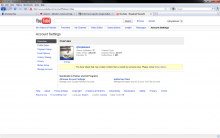If you would like to see more information on this case study, click here!
You can request this case study and a WCDE staff member will get back to you.
 Christopher Hoyle, a 4th year mechanical engineering student, plays many different musical instruments. He has recorded his music for several years, and began sharing his recordings on YouTube since June 2009. Within two years he had posted 37 musical videos, received over 220,000 views, and gained over 1880 subscribers. Christopher currently receives approximately 600 views per day on his YouTube channel. As a strategy to increase the uniqueness of his YouTube channel, Christopher would like to design and build a new and unique sounding musical instrument that he can share with his YouTube audience. Having broad experience with a range of musical instruments, Christopher understands which principles contribute to the design of a good musical instrument. For this application, the new instrument must be acoustic, create sound using natural energy, and be able to play standard notes, scales and songs.
Christopher Hoyle, a 4th year mechanical engineering student, plays many different musical instruments. He has recorded his music for several years, and began sharing his recordings on YouTube since June 2009. Within two years he had posted 37 musical videos, received over 220,000 views, and gained over 1880 subscribers. Christopher currently receives approximately 600 views per day on his YouTube channel. As a strategy to increase the uniqueness of his YouTube channel, Christopher would like to design and build a new and unique sounding musical instrument that he can share with his YouTube audience. Having broad experience with a range of musical instruments, Christopher understands which principles contribute to the design of a good musical instrument. For this application, the new instrument must be acoustic, create sound using natural energy, and be able to play standard notes, scales and songs.
Christopher set out to design and build a unique sounding musical instrument that will complement his own singing voice. He undertook this effort as a two-term design project, supervised by Oscar Nespoli at the University of Waterloo.
The teaching objective of this case is to illustrate engineering design process. The main expected learning outcome is for students to practice design synthesis. It is intended that the case study be open-ended, where students will need to move through the engineering design process, and conceptualize adequate solutions based on the design requirements. Courses the case could be used in include mechanical and system design concept courses (ME 100 and SYDE 161). Other courses the case could be applicable include SYDE 361 (Introduction to Design), and ME 380 (Mechanical Engineering Design Workshop).
If you would like to see more information on this case study, click here!
You can request this case study and a WCDE staff member will get back to you.
Contact Waterloo Cases in Design Engineering
Steve Lambert
Tel: (519) 888-4728
Email: steve@uwaterloo.ca
The University of Waterloo acknowledges that much of our work takes place on the traditional territory of the Neutral, Anishinaabeg, and Haudenosaunee peoples. Our main campus is situated on the Haldimand Tract, the land granted to the Six Nations that includes six miles on each side of the Grand River. Our active work toward reconciliation takes place across our campuses through research, learning, teaching, and community building, and is co-ordinated within the Office of Indigenous Relations.